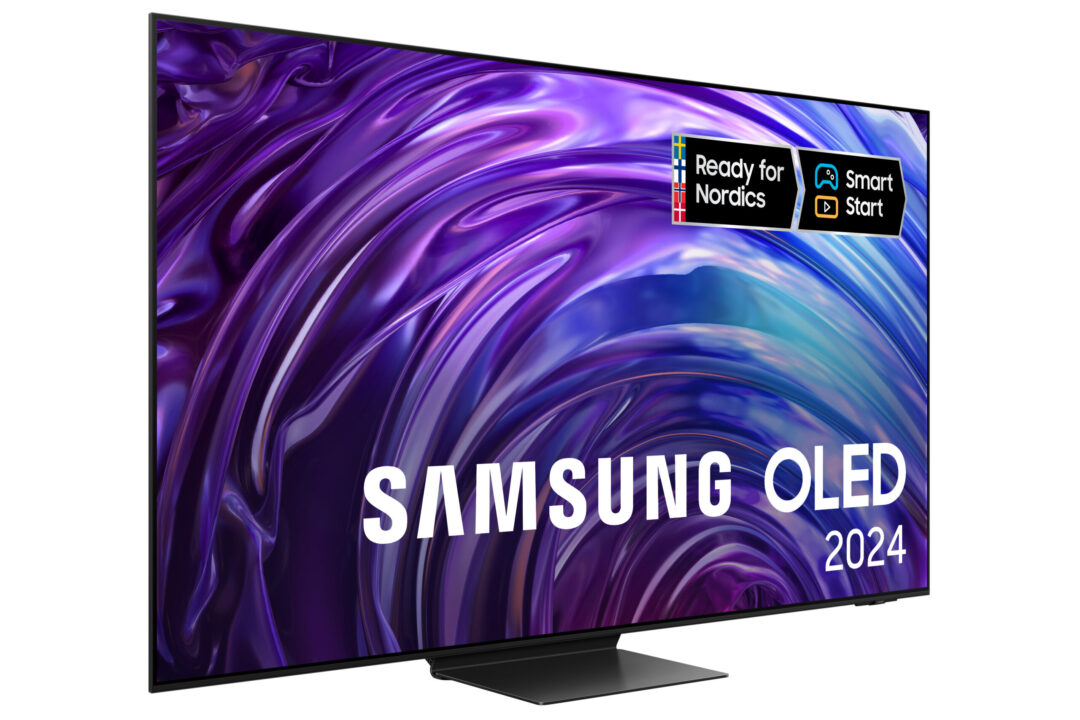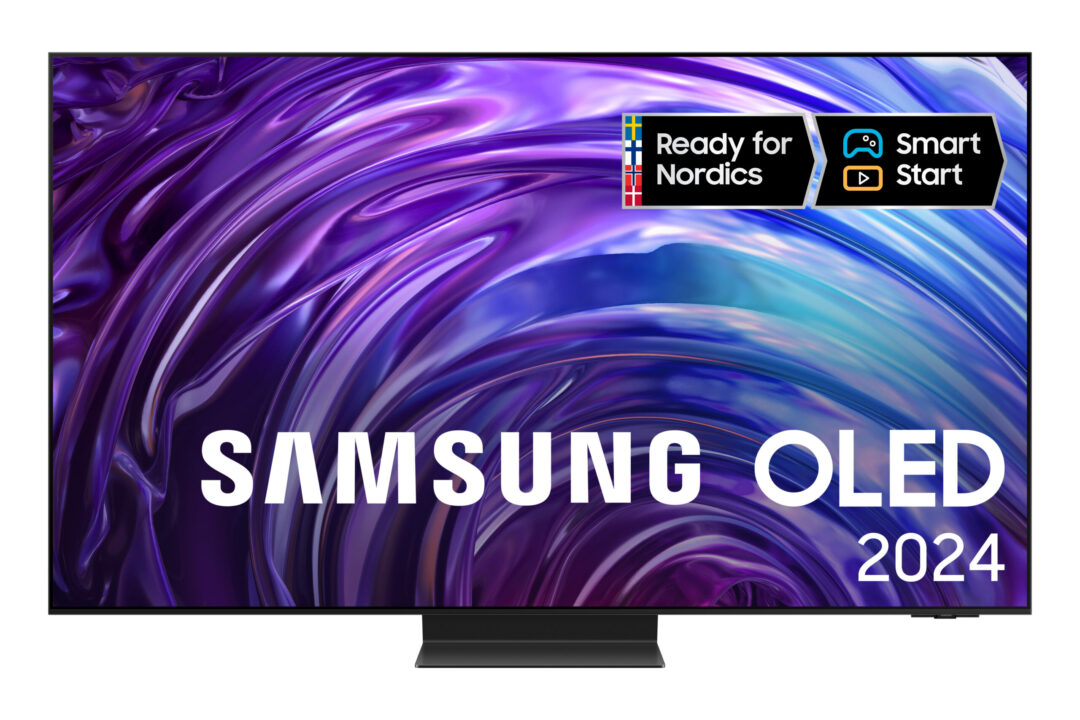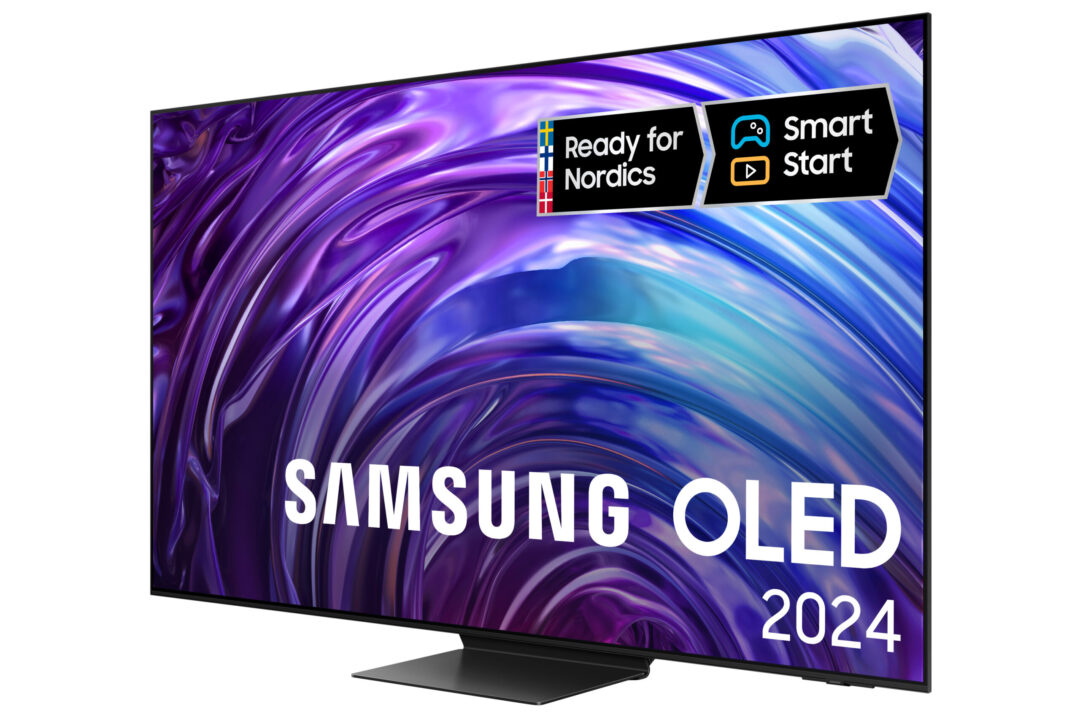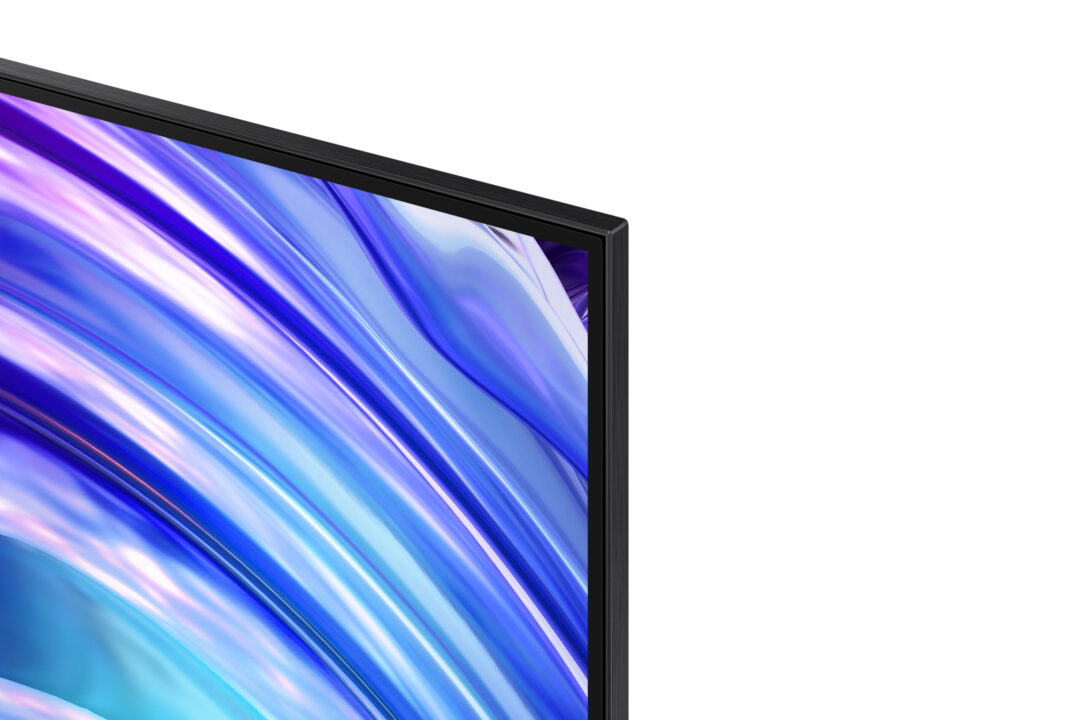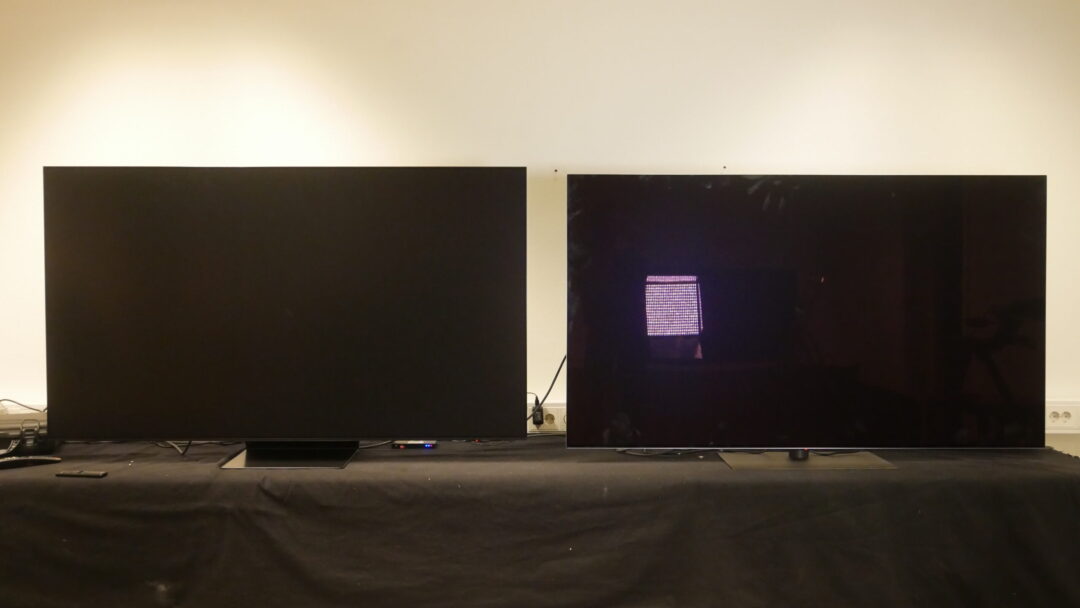The Samsung S95D is the South Korean manufacturer’s top OLED TV for 2024, and it’s something you can see, hear and feel. There’s very little left to chance here.
The top model, the S95C from 2023, almost made it to the top in last year’s test. And now its successor, the S95D, is ready to compete – equipped with an upgraded QD-OLED panel and a smarter AI video processor as some of the key improvements.

Samsung S95D – design
This year’s new top model has the same basic design as last year’s model, but there are some key differences. The first thing we notice when we unpack the Samsung screen is the super matte screen glass.
The S95D is covered in a plastic film during shipping, but when it comes off, it’s like staring into a black hole! Your eyes will struggle to focus because there’s simply nothing to focus on. The super matte surface soaks up almost all the light coming in. In comparison, the LG screen we’re standing next to is relatively glossy and characterised by reflections/mirror images.
The screen’s ‘body’ is also one of the most gorgeous things we’ve seen. Samsung’s OLED display is only 1.1 centimetres thick – less than half as thick as the LG competitor. How is that possible?
The trick, as usual, is that the power supply, electronics and connections have been moved to a separate box, Slim One Connect. That way, the display stays just as slim and flat throughout without anything protruding.
You can choose to place the connection box on the back of the base or hide it in a shelf, for example. Of course, this solution looks very tidy if you mount the TV on the wall. A longer cable is included for this purpose, but it’s relatively thick due to the power requirements.
Samsung S95D – usability and features
Samsung favour their own operating system and user interface, Tizen OS, which has also received a small facelift this year. The main menu has been made clearer to reflect the many apps and services available, and we like that it’s now easier to bring up the settings menu as a pop-up on the screen instead of having to go through a lot of menus and button presses. The app selection is impeccable as usual, and for those who like that sort of thing, there’s also access to a lot of free TV channels via Samsung TV+. Baywatch, anyone?
Samsung has also made sure that hardcore gamers have plenty of features to enjoy. For example, you get four full-bandwidth HDMI inputs. The OLED panel can handle speeds of up to 144 Hz and a separate Game Bar menu gives us a full overview of the relevant settings.
Format support is good, but Samsung still needs to support Dolby Vision HDR for games, films and streaming services. However, there is full support for Dolby Atmos, both via the built-in speaker system and via the HDMI eARC output.
Measurements
Our first measurements showed that both the LG OLED G4 and Samsung S95D provide very accurate colours and greyscale, straight out of the box and without calibration. Both displays delivered a delta deviation of <3, which is typically below what the human eye can perceive. The LG delivered exceptionally well in SDR. On the other hand, the Samsung S95D actually delivered even better in HDR with very low deviations in colour and greyscale. LG, on the other hand, delivered slightly higher brightness and contrast.
Note: The slightly higher deviations on the LG display are due to slightly higher colour values in blue, which can be compensated for with a Calman calibration. With the Samsung, there is almost no need to calibrate as the readings are already so low.
| Measurements | LG OLED65G4 | Samsung TQ65S95D |
| Colour reproduction SDR (dE) | 1,2 | 1,6 |
| Greyscale SDR (dE) | 0,6 | 1 |
| Colour reproduction HDR (dE) | 2,4 | 1,9 |
| Grreyscale HDR (dE) | 2,4 | 1,5 |
| Brightness (HDR) | ||
| 10 % | 1621 nits | 1531 nits |
| 100 % | 249 nits | 296 nits |
| Contrast (SDR) | 37613:1 | 10190:1 |
| Contrast (HDR) | 53678:1 | 39733:1 |
Image quality
The first impression is that the new Glare Free OLED panel has a rather significant and mesmerising impact on the viewing experience. Most TV screens have a rather mirror-like surface, but the Samsung screen has almost no reflections from the surroundings in the room, including lamps, windows or other objects. Even the direct light from the mobile phone’s flashlight at close range is wiped away! The result is a screen that is incredibly clean and free from visual distractions – only the image shines.
However, the matte screen is not without its side effects. Because the panel lacks the glossy, ‘highly polished’ finish, it also loses some of its absolute black level in some surroundings. The screen also becomes slightly lighter and greyish when exposed to light from the sides.
Looking at the Samsung S95D and LG OLED G4 side by side in a bright room, it’s clear that the latter has a deeper black level and slightly glossier and more polished images. The S95D can sometimes seem a little more flat in appearance, while losing some detail in dark scenes.
On the other hand, there were many other instances where the Samsung display looked noticeably cleaner and sharper thanks to the matte finish. And when the light is dimmed or switched off, there is little difference in the black level. And here the Samsung display will have a significant advantage in many cases, especially if you have lamps or windows directly behind your sofa. So you simply have to prioritise based on your own preferences and the lighting conditions in your home.
In addition, the matt surface seems to be significantly less sensitive to grease marks. Fingerprints are far more visible on the glossy LG screen…
Razor-sharp images
When the images actually appear on the screen, there’s a lot to be excited about. The S95D provides a very sharp and contrasty image experience with a characteristic, almost 3D-like depth effect. The latter is probably also largely thanks to Samsung’s powerful AI image processing. Of course, 4K images in HDR format look great on this display thanks to excellent contrast and brightness. But we’re also impressed with the image quality from more common video sources without HDR.
The video processor does an excellent job of upscaling different video sources, making even our old Blu-ray films look like 4K. There’s very little ‘sawtooth’ or other noise to be detected here, without the image feeling unnaturally polished in any way. Furthermore, the S95D retains good image sharpness, even when moving.
QD-OLED displays have traditionally had a strong advantage in colour reproduction. The S95D is no exception in this regard, and there is no doubt that the Samsung display has very rich and nuanced colours, which are also measured very accurately. However, it seems that LG has managed to make up for lost time here, as their MLA OLED display has also achieved very impressive colour reproduction.
All in all, there’s no doubt that both of these OLED displays perform very well. You can’t go wrong with either of these high-end TVs. When it comes to pure picture quality, LG has a slight advantage thanks to slightly higher contrast and deeper black levels in certain lighting conditions. While the Samsung screen will probably be the most practical and usable in many cases.
Sound quality
The Samsung screen is only half as thick as the LG screen, but you wouldn’t think so when you hear the sound. The Samsung S95D has a significantly richer and more powerful sound reproduction than the LG OLED G4, and that’s because it has several rather large speaker units spread around the back. Together, they manage to create a fairly large, wide and clear soundstage.
The voice reproduction comes through clearly, while the music and sound effects are rich. You can get by without a separate sound system – but of course it’s much better if you add a soundbar. Then you can also utilise the Q Symphony feature, which uses all the TV’s speakers together with the soundbar. We’ve tested this with the latest soundbar, the HW-Q995D, and have to admit that it gives a pretty cool effect.
Conclusion
Samsung has given its OLED top model a welcome update for 2024 with a new display panel and a more powerful video processor under the hood. It’s undoubtedly a very good-looking, potent and high-performance TV.
We especially like the sleek design and consistent ease of use. In addition, the new super matte picture panel ensures a fantastic, glare-free viewing experience. The competition is strong in the high-end segment and the picture performance is only a whisker away from the LG OLED G4, and overall, the Samsung S95D is still one of the very best OLED displays we’ve tested in 2024.

We think
The Samsung S95D delivers a high-contrast and colourful image with virtually no reflections from the screen. It also impresses with its attractive design and excellent sound. The matt screen surface may have some side effects depending on the lighting conditions in the room. The Samsung display does not support the HDR format Dolby Vision.
3699 €
Specifications
- Size/type: 65″ 4K QD OLED
- Resolution: 3,840 × 2,160 (4K Ultra HD)
- Panel frequency: 60-144Hz
- Operating system: Tizen
- Inputs: 4 x HDMI (4 x 2.1), 3 x USB
- Outputs: Optical digital audio output, HDMI eARC
- HDR: HDR10+
- Screen sizes: 55, 65, 77
- Other: 4.2.2 sound system, Separate Slim One Connect box
- Web: samsung.com


